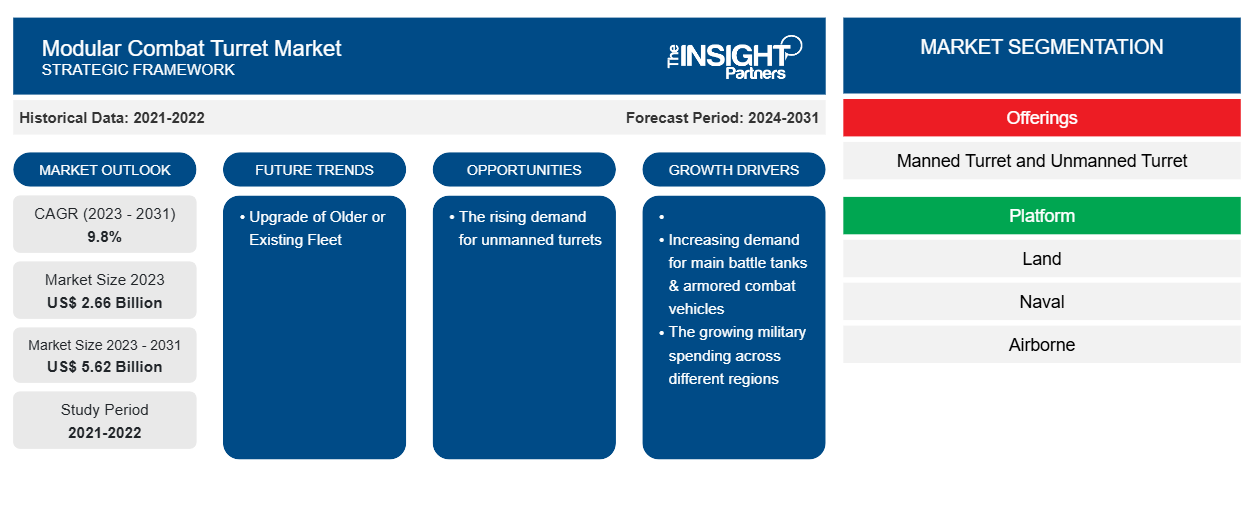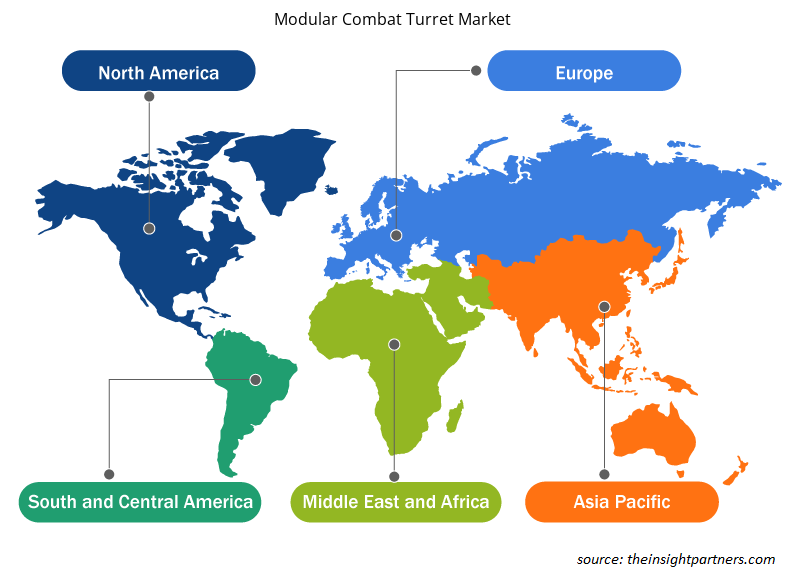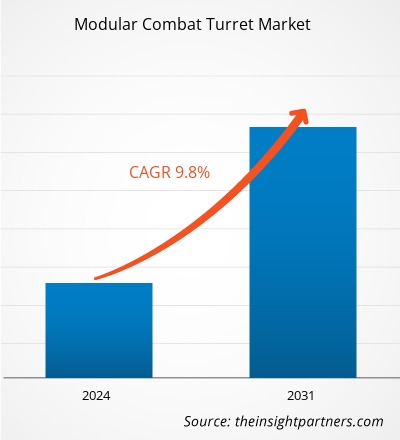The modular combat turret market size is projected to reach US$ 5.62 billion by 2031 from US$ 2.66 billion in 2023. The market is expected to register a CAGR of 9.8% during 2023–2031. The rising demand for unmanned turrets is likely to remain a key trend in the market.
Modular Combat Turret Market Analysis
The large and well-established turret manufacturers are investing substantial amount in the manufacturing of both unmanned and manned turret. Defense forces and armored vehicle manufacturers are the key buyers of modular combat turrets. Since the procurement of personal carriers armored vehicles, naval ships, aircraft carriers, frigates, and tanks among the military forces are increasing at a considerable rate, which has been showcasing constantly higher bargaining power of buyers in the modular combat turret market. Also, the defense forces are pressurizing the armored vehicle manufacturers to supply higher volumes vehicles which is highlighting the pressure on the turret manufacturers. The constant rise in adoption of the vehicles mentioned above is also foreseen to develop the bargaining power of buyers during the forecast period.
Modular Combat Turret Market Overview
The major stakeholders in the global modular combat turret market ecosystem include component manufacturers, turret manufacturers and suppliers and end-user. With the rising demand for modular combat turret across the globe, the component providers of turret are also experiencing a rise in demand. The components of turret system include motor controller, power unit, stabilization unit, turret drive, among others. The direct impact of the high demand is however on the modular combat turret providers/manufacturers who cater to variety of military and defense needs. The rising expenditure of military and defense capability and the growing need for replacing old and obsolete tanks and system is creating the demand for modular combat turret. Some of the key modular combat turret solution providers operating in the global market include: BAE Systems, Control Solution LLC, Curtiss-Wright Corporation, Denel Dynamics, Elbit System Ltd., Jenoptik AG, Leonardo S.P.A, Moog Inc., Rheinmetall AG among others
Customize This Report To Suit Your Requirement
You will get customization on any report - free of charge - including parts of this report, or country-level analysis, Excel Data pack, as well as avail great offers and discounts for start-ups & universities
Modular Combat Turret Market: Strategic Insights

- Get Top Key Market Trends of this report.This FREE sample will include data analysis, ranging from market trends to estimates and forecasts.
You will get customization on any report - free of charge - including parts of this report, or country-level analysis, Excel Data pack, as well as avail great offers and discounts for start-ups & universities
Modular Combat Turret Market: Strategic Insights

- Get Top Key Market Trends of this report.This FREE sample will include data analysis, ranging from market trends to estimates and forecasts.
Modular Combat Turret Market Drivers and Opportunities
Rise in Military Expenditure
The swift change in modern-day warfare has been urging the governments to allocate higher amounts toward respective military forces. The budget allocated to military helps the military forces to engage themselves in the development of robust indigenous technologies and procurement of advanced weapons, armaments, vehicles, and other equipment from international manufacturers. There is a rise in modernization of soldiers and military vehicles among most of the military forces in order to keep the personnel and vehicles mission ready. With an objective to modernize soldiers and vehicles, the defense ministries across the globe are investing substantial amounts in newer technologies, including advanced modular combat turret. This factor is boosting the growth of the global modular combat turret market. According to the Stockholm International Peace Research Institute (SIPRI), the global military expenditure rose to US$ 2,443 billion in 2023 witnessing around 13% rise compared to 2022. The key countries in 2023, which accounted for ~60% of global expenditure, include the US, China, India, Russia, and Saudi Arabia. Such investments have been boosting the procurement and orders for military modular combat turret from across different countries worldwide which is further driving the market growth.
Upgrade of Older or Existing Fleet
There is a growing need for upgrading or replacing old tanks and armored vehicles. Countries have been spending huge amount in this direction. For instance, five of the biggest spenders on these fleet includes China, India, Australia, Pakistan, and South Korea. China invested more than US$ 15 billion to replace thousands of aging and outdated vehicles in 2023. India is also one of the prominent markets for main battle tanks. The country is expected to spend significantly on Future Infantry Combat Vehicle program, which is aiming to replace over 2000 BMP-2 IFVs. Moreover, the Indian army is likely to issue a Request for Proposal (RFP) in 2024 for a mega project worth an estimated US$ 6.84 billion. Pakistan is also responding to the increased procurement of such vehicles by the Indian government. The country is investing heavily in its own projects and therefore emerging as one of the leading procurers of defense and military vehicle fleet. Apart from these countries, Singapore and Indonesia are also procuring new and upgraded vehicle fleets. Such factors are likely to generate new opportunities for modular combat turret in the coming years across different regions.
Modular Combat Turret Market Report Segmentation Analysis
Key segments that contributed to the derivation of the modular combat turret market analysis are offerings and platfrom.
- Based on offering, the modular combat turret market is segmented into manned turret and unmanned turret. The manned turret segment held a larger market share in 2023.
- Based on platform, the modular combat turret market is segmented into land, naval, and airborne. The land segment held a larger market share in 2023.
Modular Combat Turret Market Share Analysis by Geography
The geographic scope of the modular combat turret market report is mainly divided into five regions: North America, Europe, Asia Pacific, Middle East & Africa, and South America.
North America has dominated the market in 2023 followed by Europe and Asia Pacific regions. Further, Asia Pacific is also likely to witness highest CAGR in the coming years. The US dominated the North America modular combat turret market in 2023. The US is a technologically advanced country known for adopting technologies at an early phase. The country maintains the top spot position as an undisputed military power across the globe both in context to personnel and technology. In 2023, the US has spent US$ 916 billion on its military expenditure. The stronger the country's military, the more the expenditure on procuring technologies, including modular combat turret. Furthermore, the country witness’s presence of companies such as CMI Group, Control Solutions LLC, Curtiss-Wright Corporation, and Lockheed Martin Corporation is another factor after highest military expenditure which will help in impacting the market growth. Also, the country has experienced few initiatives that are anticipated to contribute significantly towards the market growth.
Modular Combat Turret Market Regional Insights
The regional trends and factors influencing the Modular Combat Turret Market throughout the forecast period have been thoroughly explained by the analysts at The Insight Partners. This section also discusses Modular Combat Turret Market segments and geography across North America, Europe, Asia Pacific, Middle East and Africa, and South and Central America.

- Get the Regional Specific Data for Modular Combat Turret Market
Modular Combat Turret Market Report Scope
| Report Attribute | Details |
|---|---|
| Market size in 2023 | US$ 2.66 Billion |
| Market Size by 2031 | US$ 5.62 Billion |
| Global CAGR (2023 - 2031) | 9.8% |
| Historical Data | 2021-2022 |
| Forecast period | 2024-2031 |
| Segments Covered |
By Offerings
|
| Regions and Countries Covered | North America
|
| Market leaders and key company profiles |
Modular Combat Turret Market Players Density: Understanding Its Impact on Business Dynamics
The Modular Combat Turret Market is growing rapidly, driven by increasing end-user demand due to factors such as evolving consumer preferences, technological advancements, and greater awareness of the product's benefits. As demand rises, businesses are expanding their offerings, innovating to meet consumer needs, and capitalizing on emerging trends, which further fuels market growth.
Market players density refers to the distribution of firms or companies operating within a particular market or industry. It indicates how many competitors (market players) are present in a given market space relative to its size or total market value.
Major Companies operating in the Modular Combat Turret Market are:
- BAE Systems
- Control Solution LLC
- Curtiss-Wright Corporation
- Denel Dynamics
- Elbit System Ltd.
Disclaimer: The companies listed above are not ranked in any particular order.

- Get the Modular Combat Turret Market top key players overview
Modular Combat Turret Market News and Recent Developments
The modular combat turret market is evaluated by gathering qualitative and quantitative data post primary and secondary research, which includes important corporate publications, association data, and databases. A few of the developments in the modular combat turret market are listed below:
- The Challenger 3 programme has reached an important milestone. The contract has now been signed for Rheinmetall BAE Systems Land (RBSL) to deliver a new modular armour system on the Challenger 3 Main Battle Tank. (Source: Rheinmetall BAE Systems Land, Press Release, Jan 2024)
- John Cockerill is proud to present at DSEI 2023 its innovative range of products that combine modularity, reliability and high performance, the Cockerill i-X vehicle and the Cockerill 1030 turret. John Cockerill also presents the 30 mm version of the Tank Boat. (Source: John Cockerill, Press Release, Sep 2023)
Modular Combat Turret Market Report Coverage and Deliverables
The “Modular Combat Turret Market Size and Forecast (2021–2031)” report provides a detailed analysis of the market covering below areas:
- Modular combat turret market market size and forecast at global, regional, and country levels for all the key market segments covered under the scope
- Modular combat turret market market trends as well as market dynamics such as drivers, restraints, and key opportunities
- Detailed porter’s five forces analysis
- Modular combat turret market market analysis covering key market trends, global and regional framework, major players, regulations, and recent market developments
- Industry landscape and competition analysis covering market concentration, heat map analysis, prominent players, and recent developments for the modular combat turret market
- Detailed company profiles
Frequently Asked Questions
What is the expected CAGR of the modular combat turret market ?
The modular combat turret market is likely to register of 9.8% during 2023-2031.
What would be the estimated value of the modular combat turret market by 2031?
The estimated value of the modular combat turret market by 2031 would be around US$ 5.62 billion.
Which are the leading players operating in the modular combat turret market ?
BAE Systems, Control Solution LLC, Curtiss-Wright Corporation, Denel Dynamics, Elbit System Ltd, Jenoptik AG, Leonardo SpA, Moog Inc, Rheinmetall AG, and John Cockerill are some of the key players profiled under the report.
What are the future trends of the modular combat turret market ?
The rising demand for unmanned turrets is one of the major trends of the market.
What are the driving factors impacting the modular combat turret market ?
Increasing demand for main battle tanks & armored combat vehicles and the growing military spending across different regions are some of the factors driving the growth for modular combat turret market.
Which region dominated the modular combat turret market in 2023?
North America region dominated the modular combat turret market in 2023.
- Historical Analysis (2 Years), Base Year, Forecast (7 Years) with CAGR
- PEST and SWOT Analysis
- Market Size Value / Volume - Global, Regional, Country
- Industry and Competitive Landscape
- Excel Dataset
- Aircraft MRO Market
- Helicopter Hoists Winches and Hooks Market
- Fixed-Base Operator Market
- Aerospace Fasteners Market
- Aerospace Stainless Steel And Superalloy Fasteners Market
- Aircraft Floor Panel Market
- Military Optronics Surveillance and Sighting Systems Market
- Smoke Grenade Market
- Airport Runway FOD Detection Systems Market
- Artillery Systems Market
Testimonials
Reason to Buy
- Informed Decision-Making
- Understanding Market Dynamics
- Competitive Analysis
- Identifying Emerging Markets
- Customer Insights
- Market Forecasts
- Risk Mitigation
- Boosting Operational Efficiency
- Strategic Planning
- Investment Justification
- Tracking Industry Innovations
- Aligning with Regulatory Trends
Yes! We provide a free sample of the report, which includes Report Scope (Table of Contents), report structure, and selected insights to help you assess the value of the full report. Please click on the "Download Sample" button or contact us to receive your copy.
Absolutely — analyst assistance is part of the package. You can connect with our analyst post-purchase to clarify report insights, methodology or discuss how the findings apply to your business needs.
Once your order is successfully placed, you will receive a confirmation email along with your invoice.
• For published reports: You’ll receive access to the report within 4–6 working hours via a secured email sent to your email.
• For upcoming reports: Your order will be recorded as a pre-booking. Our team will share the estimated release date and keep you informed of any updates. As soon as the report is published, it will be delivered to your registered email.
We offer customization options to align the report with your specific objectives. Whether you need deeper insights into a particular region, industry segment, competitor analysis, or data cut, our research team can tailor the report accordingly. Please share your requirements with us, and we’ll be happy to provide a customized proposal or scope.
The report is available in either PDF format or as an Excel dataset, depending on the license you choose.
The PDF version provides the full analysis and visuals in a ready-to-read format. The Excel dataset includes all underlying data tables for easy manipulation and further analysis.
Please review the license options at checkout or contact us to confirm which formats are included with your purchase.
Our payment process is fully secure and PCI-DSS compliant.
We use trusted and encrypted payment gateways to ensure that all transactions are protected with industry-standard SSL encryption. Your payment details are never stored on our servers and are handled securely by certified third-party processors.
You can make your purchase with confidence, knowing your personal and financial information is safe with us.
Yes, we do offer special pricing for bulk purchases.
If you're interested in purchasing multiple reports, we’re happy to provide a customized bundle offer or volume-based discount tailored to your needs. Please contact our sales team with the list of reports you’re considering, and we’ll share a personalized quote.
Yes, absolutely.
Our team is available to help you make an informed decision. Whether you have questions about the report’s scope, methodology, customization options, or which license suits you best, we’re here to assist. Please reach out to us at sales@theinsightpartners.com, and one of our representatives will get in touch promptly.
Yes, a billing invoice will be automatically generated and sent to your registered email upon successful completion of your purchase.
If you need the invoice in a specific format or require additional details (such as company name, GST, or VAT information), feel free to contact us, and we’ll be happy to assist.
Yes, certainly.
If you encounter any difficulties accessing or receiving your report, our support team is ready to assist you. Simply reach out to us via email or live chat with your order information, and we’ll ensure the issue is resolved quickly so you can access your report without interruption.





















 Get Free Sample For
Get Free Sample For